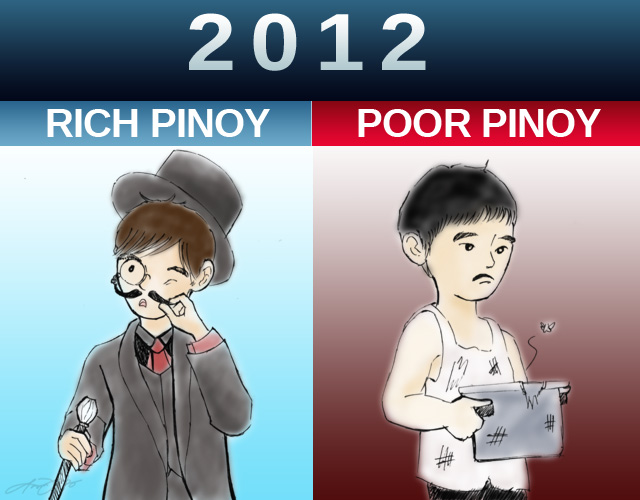Filtered By: Money
Money
Rich Pinoy, Poor Pinoy: Poverty amid a booming economy
By SIEGFRID O. ALEGADO, GMA News
Metro Manila these days is marked by crane-topped cities rising as the property market booms albeit alongside slums – poverty-stricken households whose hungry members marvel at multimillion-peso-per unit high rises amid a much-vaunted strong economy and fiscal position.
Rosy prospects for the Philippines, backed by fiscal, monetary and political reforms, have prompted consecutive upgrades in its growth outlook for 2012 and beyond, capped by innuendos of a possible credit rating upgrade to the coveted investment grade by global debt watchers.
But these developments mean little for the poor, which comprise more than a quarter of the nearly 100 million population, unless structural changes in the manufacturing sector take place.
Philippine “growth will continue, but with no significant poverty reduction,” Norio Usui, Manila-based economist at Asian Development Bank, said in an e-mail correspondence with GMA News Online. “I call this problem as growth without development.” 

Inclusive growth While the inter-agency Development Budget Coordination Committee targets a 6 to 7 percent growth next year and 6.5 to 7.5 percent in 2014, Socioeconomic Planning Secretary Arsenio Balisacan admits achieving “inclusive growth” will take a little longer.
“Achieving rapid economic growth is one thing, and inclusive growth is clearly another,” Balisacan said.
Usui has described what ails the Philippines: “The current growth model that depends heavily on consumption (backed by remittances from overseas Filipinos) and services sector cannot do it.”
The 6.5 percent gross domestic product (GDP) growth in the first three quarters – the fastest among the Association of Southeast Asian Nations – was fueled by consumer spending as well as a slight uptick in public expenditure, the National Statistics Office reported.
In a separate interview, University of Asia and the Pacific (UA&P) economist Victor Abola said growth will only trickle down to the grassroots if it is coupled with a strong manufacturing sector that employs Filipinos.
“The country's strong growth will not address poverty if quality employment is not generated,” he said. “Growth would mean more if local industries are strengthened, translating to more domestic employment.”
Despite the pace of growth, the Philippines recorded a 6.8 percent jobless rate in October from 6.4 percent a year earlier, according to the latest Labor Force Survey released on Tuesday.
“Generating employment and ensuring that these are of good quality remain our greatest challenge,” Balisacan said, noting the latest employment data.
Jobs in manufacturing
Citing an already strong services sector on the back of a booming business process outsourcing (BPO) industry, ADB's Usui noted the importance of strengthening manufacturing in order to generate more jobs.
“Compared with regional peers, the Philippines does not have a strong industrial base that can create productive jobs for the wider segments of Filipino workers – both skilled and unskilled workers,” Usui added.
Historical data shows that the share of manufacturing to GDP peaked at around 40 percent in the 1980s, but has since plummeted to a little over 20 percent in the third quarter in 2012.
Foreign firms looking for an ideal relocation site provide an opportunity to revive the sector. But developing industries and attracting more investments is not a walk in the park.
“The government needs to address the long-term challenges such as deficient infrastructure and poor governance (business and investment climate),” Usui said.
“On top of these traditional constraints, the authorities should realize that there exist huge business opportunities at the product level,” he added.
UA&P's Abola noted, “Better local industries could be achieved if the government hones local resources and tempers volatility in the exchange rate to support small manufacturers.”
For the government, Balisacan said the Aquino administration is boosting efforts to shore up more investments and reduce the cost of doing business.
He said the “institutional reforms that we have started are undeniably pushing the frontiers of our economy and accelerating the confidence in the market
“We hope to institute more reforms, and it is our earnest desire that these reforms in the bureaucracy should fully cascade in all the departments and local government units,” Balisacan added.
The official said the government is also finding ways to mitigate the “appreciation of our currency that is threatening to erode our competitiveness.”
The policy-setting Monetary Board has been looking at ways to curb foreign exchange volatility, he said. A tiger on two legs
Big-ticket infrastructure projects under the flagship public-private partnership (PPP) program is also seen addressing the infrastructure gap.
The government has targeted to roll-out eight PPP projects this year, seven of which are already in advanced bidding stages.
Delays, however, marred the program, with government claiming that delays were due to stringent review process.
So far, only two PPP projects – the P1.96-billion Daang Hari- South Luzon Expressway Link Road project and the P16.5-billion School Infrastructure Project Phase I – have been awarded since the flagship program was unveiled with much fanfare in late 2010.
But with good fundamentals and an economy hurtling forward, both Abola and Usui share the view that the gates of change are still open for the Philippines.
The country is just treading a long, arduous road into losing the title “Asia's laggard,” said Abola.
“When the Philippine economy can start waking on two legs – on industry and services (BPOs) – the country can be a new tiger even it will be a latecomer,” Usui noted. — VS, GMA News
More Videos
Most Popular




